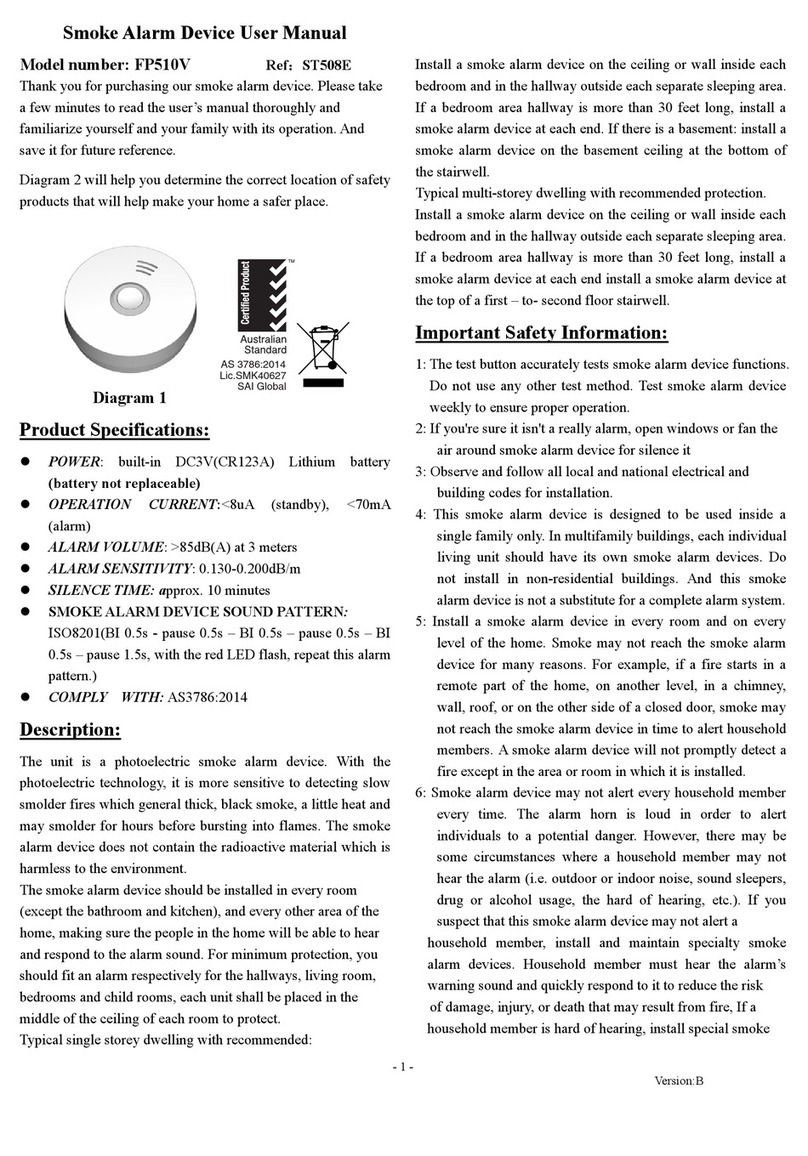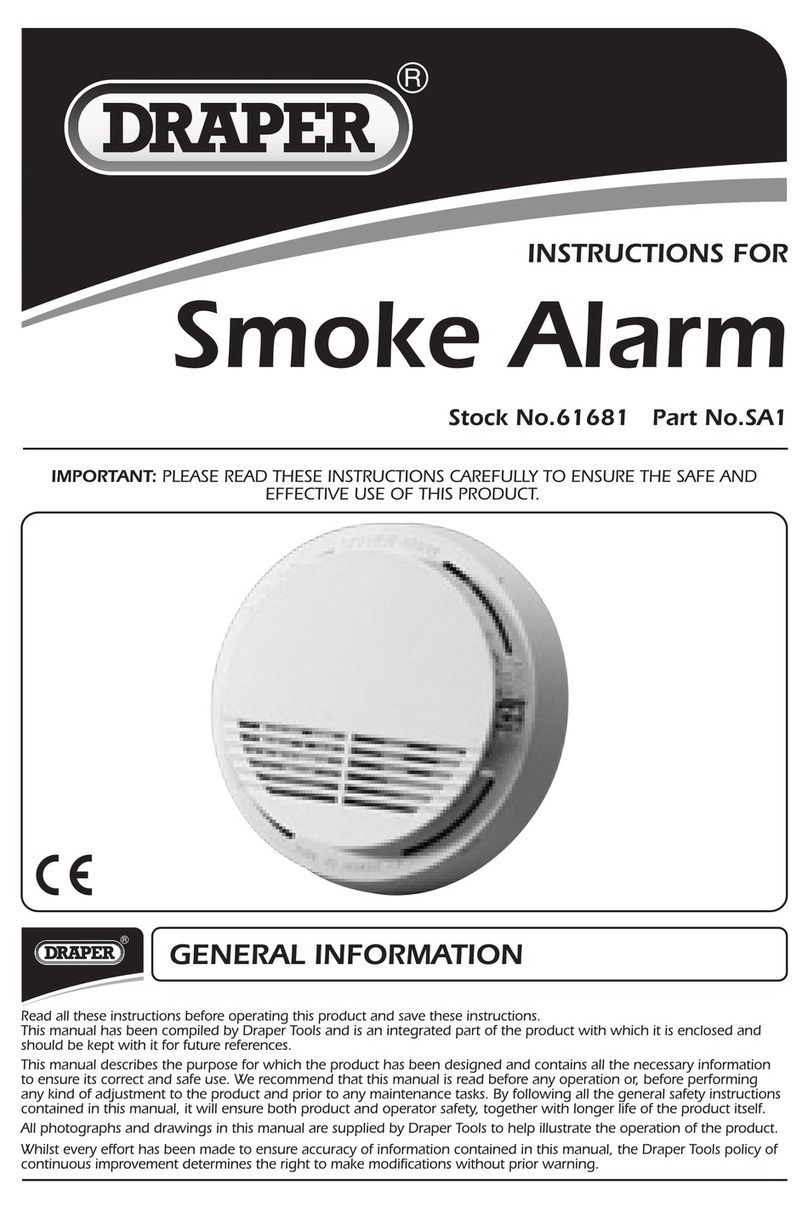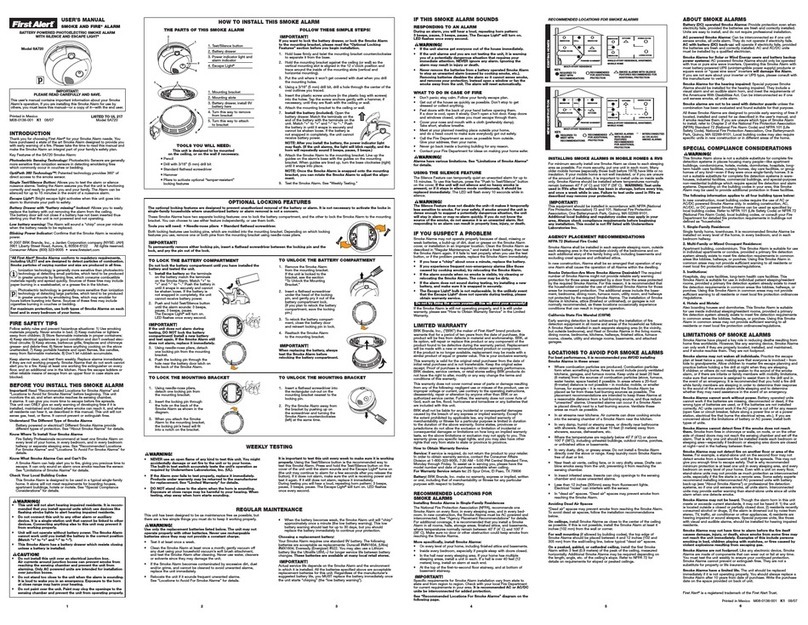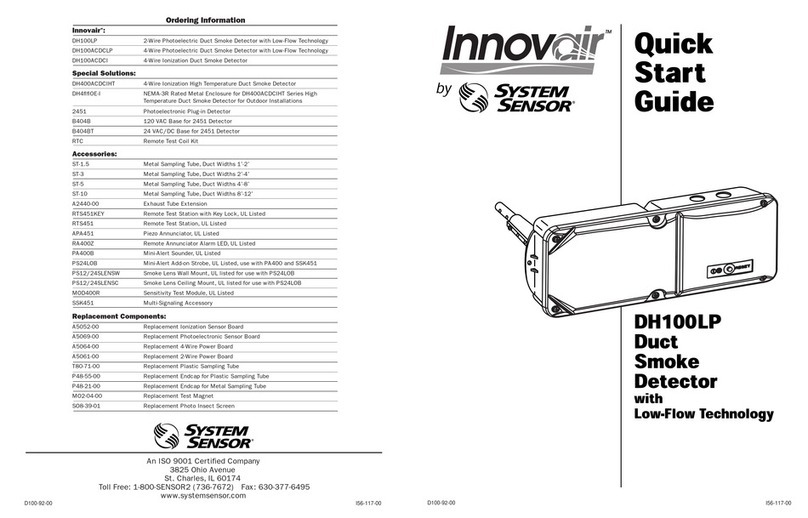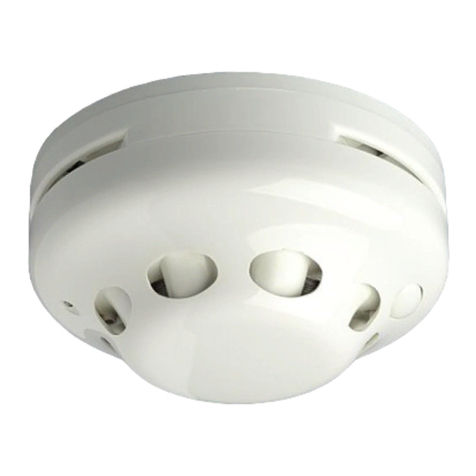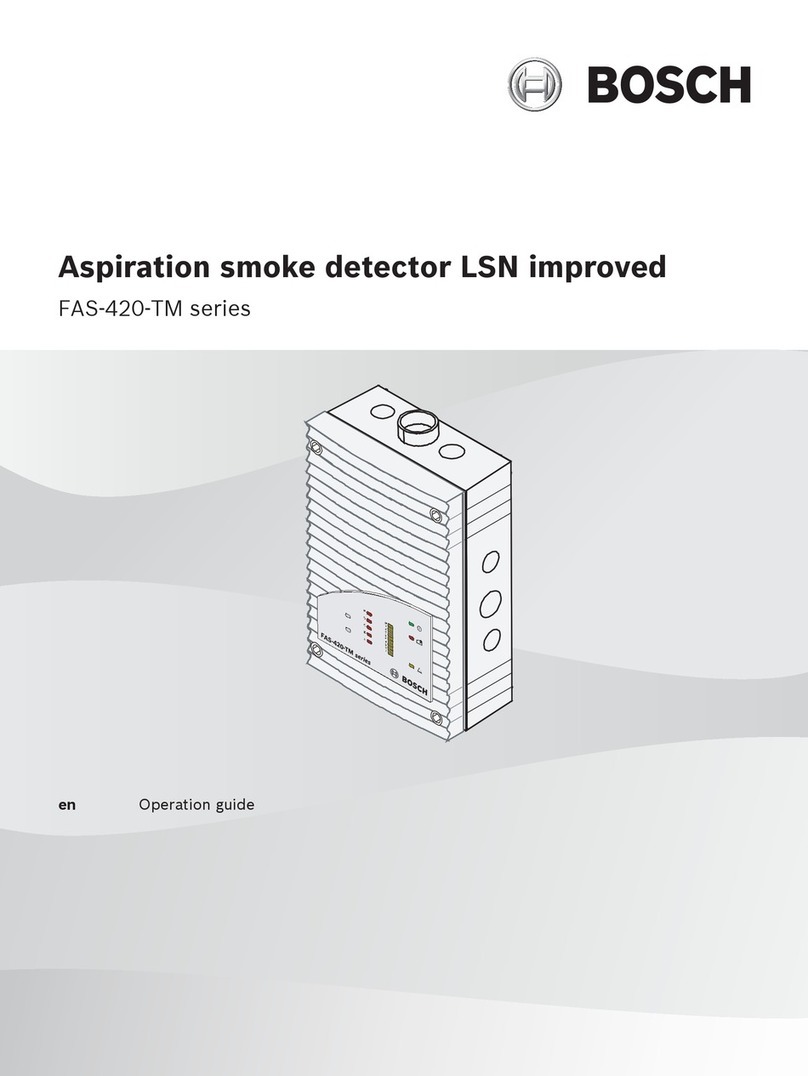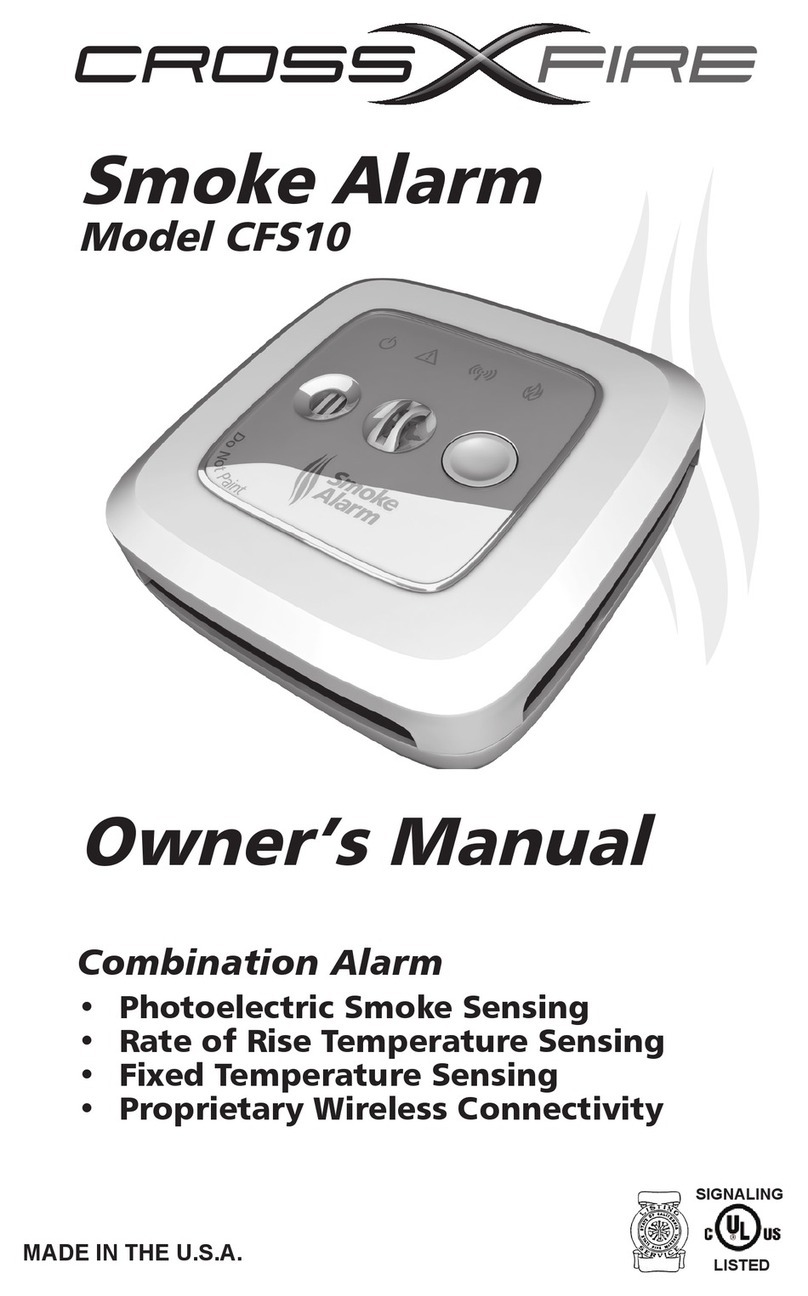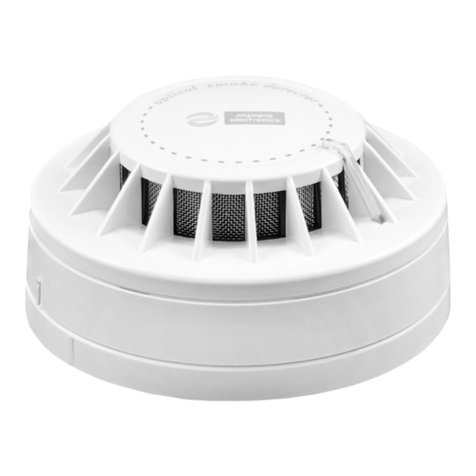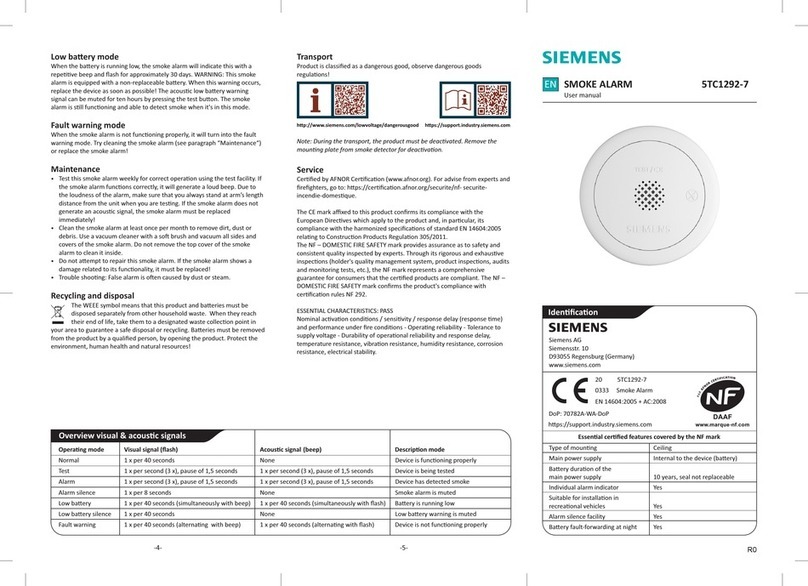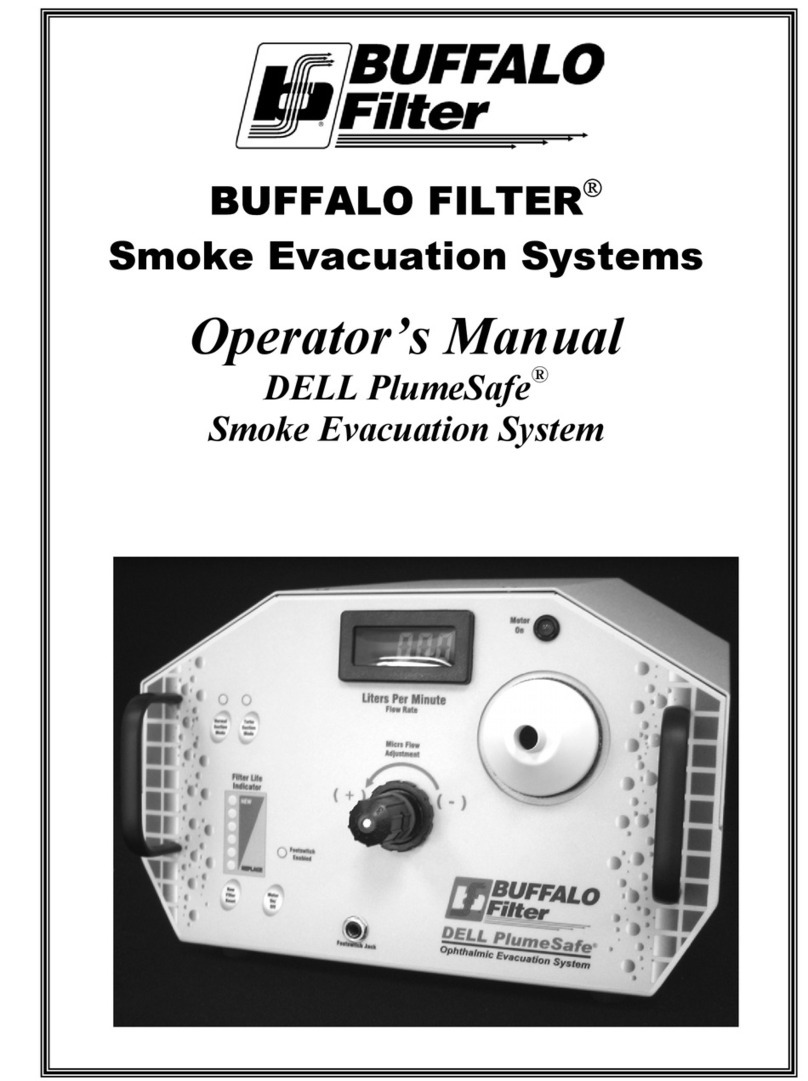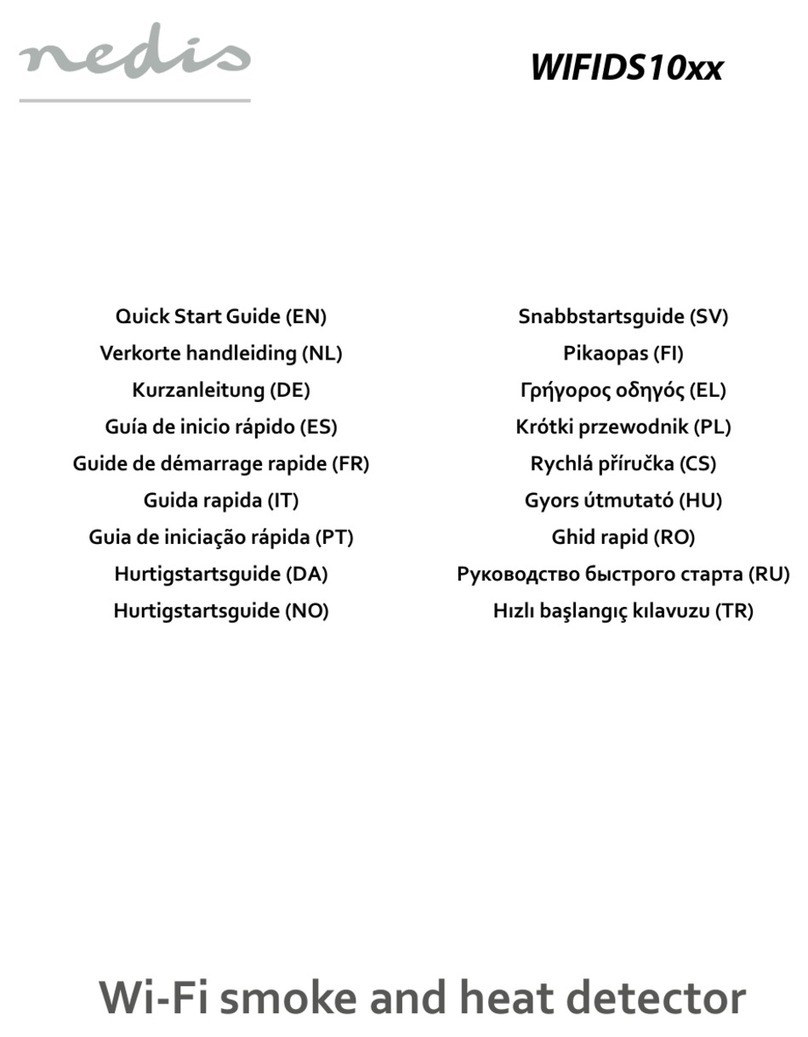Fire Pro FP510V User manual

Smoke Alarm Device User Manual
Model number: FP510V
Thank you for purchasing our smoke alarm. Please take a few
minutes to read the user’s manual thoroughly and familiarise
yourself and your family with its operation and save it for
future reference.
Diagram 2 will help you determine the correct location of
safety products that will help make your home a safer place.
Diagram 1
Product Specications:
• POWER: built-in DC3V(CR123A) Lithium battery
(battery not replaceable)
• OPERATION CURRENT: <8uA (standby), <70mA
(alarm)
• ALARM VOLUME: >85dB(A) at 3 meters
• ALARM SENSITIVITY: 0.130-0.200dB/m
• SILENCE TIME: approx. 10 minutes
• SMOKE ALARM DEVICE SOUND PATTERN:
ISO8201(BI 0.5s - pause 0.5s – BI 0.5s – pause 0.5s – BI
0.5s – pause 1.5s, with the red LED ash, repeat this alarm
pattern.)
• COMPLY WITH: AS3786:2014
Description:
The unit is a photoelectric smoke alarm device. With the
photoelectric technology, it is more sensitive to detecting
slow smoulder res which generally have thick, black smoke,
a little heat and may smoulder for hours before bursting
into ames. The smoke alarm device does not contain the
radioactive material which is harmless to the environment.
Smoke alarms should be installed in every room and area of
the home (except the bathroom and kitchen), to ensure the
everyone in the home will be able to hear and respond to the
alarm sound. For minimum protection you should t an alarm
in the hallway between the living areas, bedrooms and child
rooms. Each unit shall be placed in the middle of the ceiling
of each room.
Typical single storey dwelling recommended protection:
Install a smoke alarm device on the ceiling or wall inside
each bedroom and in the hallway outside each separate
sleeping area. If a bedroom area hallway is more than 9.1m
long, install a smoke alarm device at each end. If there is
a basement: install a smoke alarm device on the basement
ceiling at the bottom of the stairwell.
Typical multi-storey dwelling recommended protection.
Install a smoke alarm device on the ceiling or wall inside each
bedroom and in the hallway outside each separate sleeping
area. If a bedroom area hallway is more than 9.1m long,
install a smoke alarm device at each end install a smoke alarm
device at the top of a rst – to- second oor stairwell.
Important Safety Information:
1: The test button accurately tests smoke alarm device
functions. Do not use any other test method. Test smoke
alarm device weekly to ensure proper operation.
2: If you’re sure it isn’t a re, open windows or fan the air
around smoke alarm device for silence it
3: Observe and follow all local and national electrical and
building codes for installation.
4: This smoke alarm device is designed to be used inside a
single family residence only. In multi-family buildings,
each individual living unit should have its own smoke
alarm devices. Do not install in non-residential buildings.
This smoke alarm device is not a substitute for a complete
alarm system.
5: Install a smoke alarm device in every room and on every
level of the home. Smoke may not reach the smoke alarm
device for many reasons. For example, if a re starts in a
remote part of the home, on another level, in a chimney,
wall, roof, or on the other side of a closed door, smoke may
not reach the smoke alarm device in time to alert household
members. A smoke alarm device will not promptly detect a
re except in the area or room in which it is installed.
6: Smoke alarm device may not alert every household
member every time. The alarm horn is loud in order to
alert individuals to a potential danger. However, there may
be some circumstances where a household member may
not hear the alarm (i.e. outdoor or indoor noise, sound
sleepers, drug or alcohol usage, the hard of hearing, etc.).
If you suspect that this smoke alarm device may not alert
a household member, install and maintain specialty smoke
alarm devices. Household members must hear the alarm’s
warning sound and quickly respond to it to reduce the risk
of damage, injury, or death that may result from re, If a
- 1 -
AS 3786-2014
Lic.SMK40627
SAI Global

household member is hard of hearing, install special smoke
alarm devices with lights or vibrating devices to alert
occupants.
7: Smoke alarm devices can only sound their alarms when
they detect smoke or detect combustion particles in the air.
They do not sense heat, ame, or gas. This smoke alarm
device is designed to give audible warning of a developing
re. However, many res are fast - burning, explosive, or
intentional, and others are caused by carelessness or safety
hazards. In these circumstances smoke may not remake the
unit alarm QUICKLY ENOUGH to ensure safe escape.
8: Smoke alarm devices have limitations. This smoke alarm
device is not foolproof and is not warranted to protect
lives or property from re. Smoke alarm devices are not a
substitute for insurance. Homeowners and renters should
insure their lives and property. In addition, it is possible for
the smoke alarm device to fail at any time. For this reason,
you must test the smoke alarm device weekly and replace
unit every 10 years.
Do Not Install Smoke alarm devices in
the Following Places:
1: Near appliances or areas where normal combustion
regularly occurs (kitchens, near furnaces, hot water
heaters). Use specialised smoke alarm devices with
unwanted alarm control for these areas.
2: In areas with high humidity, like bathrooms or areas near
dishwashers or washing machines. Install at least 3m away
from these areas.
3: Near air returns or heating and cooling supply vents. Install
at least 1m away from these areas. The air could blow
smoke away from the detector, interrupting its alarm.
4: In rooms where temperatures may fall below 5°C or
rise above 45°C, or in humidity higher than 85%. These
conditions will reduce battery life or cause a fault with the
alarm.
5: In extremely dusty, dirty, or insect-infested areas particles
may interfere with smoke alarm operation.
Operation:
Testing
Test the unit to ensure proper operation by pressing the test
button, this will sound the alarm if the electronic circuitry,
horn, and battery are working. If no alarm sounds, there is a
defective battery or other failures, you can refer to “Trouble
shooting” section for a solution.
DO NOT use an open ame to test your alarm, you could
damage the alarm or ignite combustible materials and start a
re.
CAUTION: Due to the loudness (85 decibels) of the alarm,
always stand an arms-length away from the unit when testing.
Test the alarm weekly to ensure proper operation. Erratic or
low sound coming from your alarm may indicate a defective
alarm, you can refer to “Trouble shooting” section for
solution.
NOTE: WEEKLY TESTING IS REQUIRED.
LED indicators
Red LED-Flashing once every 40 seconds: indicates that the
smoke alarm device is operating properly.
Red LED-Flashing when the test button is pressed, or when
the smoke alarm device senses particles of combustion and
goes into alarm (constant pulsating sound), the red LED will
ash once per second. The ashing LED and pulsating alarm
will continue until the air is cleared or release test button.
Red LED-Alarm silencer (Hush mode) indication: The red
LED will ash once every 8 seconds, indicating the smoke
alarm device is in the alarm silence (Hush) mode.
Low battery indication - An intermittent “chirp” with red
LED ashes once every 40 seconds: indicates that the smoke
alarm device battery is low. You may press the test button to
silence alarm for 10 hours, but it will reset automatically after
10 hours.
Fault indication - The alarm chirp occurs every 40 seconds.
NOTE: When the units chirp once every 40 seconds, you can
press the test button to temporarily pause this warning tone
for 10 hours. Alarm can still normally detect smoke during
this period, it only removes nuisance warning tone. You can
refer to “Trouble shooting” for solution. If there are still a
failure, you MUST replace it with a new alarm at once or
contact your retailer during warranty period.
Alarm silence (silence mode)
If the unit is alarming, you can push the test button, to pause
the unit from alarming for approx 10 minutes. The red LED
will ash once every 8 seconds, indicating the smoke alarm
device is running in silence mode. Smoke alarm devices are
designed to minimize nuisance alarms. Combustion particles
from cooking may set off the alarm if the alarm is located
close to the cooking area. Large quantities of combustible
particles are generated from spills or when grilling/frying.
Using the fan on a range hood that vents to outside (non-
recirculating type) will also help remove these combustible
particles from the kitchen. The alarm silence (test button)
is extremely useful in a kitchen area or other areas prone to
nuisance alarms. The silence feature is to be used only when a
known alarm condition, such as smoke from cooking activates
the alarm. The smoke alarm device is desensitised by pushing
- 2 -

the alarm test button. Silence (silence mode) on the smoke
alarm device cover, the alarm will silence to indicate that the
alarm is in a temporarily desensitised condition.
The smoke alarm device will automatically reset after
approximately 10 minutes, if after this period, particles of
combustion are still present, the alarm will sound again.
The alarm silencer (silence mode) can be repeated until the air
has been cleared of the condition causing the alarm.
CAUTION: Before using the alarm silence, identify the
source of the smoke and be certain a safe condition exists.
NOTE: Dense smoke will override the alarm silencer and
will sound a continuous alarm again.
DANGER: If the alarm sounds, and it is not being tested, it
means the unit is sensing smoke, THE SOUND OF THE
ALARM REQUIRES YOUR IMMEDIATE ATTENTION
AND ACTION.
Maintenance and Cleaning:
The alarm should be cleaned at least once a year
• To clean your alarm, remove it from bracket. You can clean
it by using compressed air or a vacuum cleaner hose with a
soft brush attachment. Blow or vacuum around the perimeter
of the alarm to remove dust and dirt and debris. The outside
of the alarm can be wiped with a damp cloth but do not use a
wet cloth in order to avoid water entering the inner of alarm.
• After cleaning, reinstall it and test it by pressing the Test
button. The alarm should be replaced if cleaning can’t
restore the alarm to normal operation.
• This alarm has a low battery monitor which will cause the
alarm to “chirp” approx every 40 seconds and the red LED
ash once at the same time for a minimum of thirty days
when the battery gets low.
If there is a defective battery or other failures, you can
refer to the “Trouble shooting” section for a solution, or
deactivate this alarm to stop nuisance alarm which is caused
by a failure of their function. If there are still failures during
warranty, you can return it to your retailer.
Don’t paint the unit. Paint will seal the vents and interfere
with the sensor’s ability to detect smoke.
NOTE:
1. REGULAR WEEKLY TESTING IS REQUIRED!
2. Must reactivate alarm before use if you deactivate it.
Replacing the Alarm
It is recommended this alarm should be replaced ten years
from the date of manufacture. This date has been provided on
the product label which is located on the back of the alarm.
WARNING: The battery is sealed in the cover and not
replaceable. Please replace with another new alarm if the low
battery chirp occurs.
IMPORTANT: Do not attempt to remove the cover to clean
inside. This will affect warranty.
Repair:
If the alarm is not operating properly, and is still under
warranty, return it to the original place of purchase. Pack
it in a well-padded carton, and ship to the original place of
purchase.
If the alarm is no longer under warranty, please replace it
immediately with a comparable alarm.
Caution: Do not attempt to repair the alarm. It will affect
your warranty.
Trouble shooting:
- 3 -
Problem Trouble shooting
Smoke alarm device
does not sound
when tested.
1. Must activate alarm before
installation.
2. Clean smoke alarm device. Please
refer to the “maintenance and
cleaning” section.
3. If there are still failures during
warranty, you can return to your
retailer.
4. If the unit is out of warranty, please
replace another new alarm.
The alarm “chirps”
with red LED
ashes once every
40 seconds.
The battery is under low battery
status, please replace the smoke alarm
device.
Smoke alarm device
chirp occurs every
40 seconds (alarm
goes into fault
mode).
Clean smoke alarm device. Please
refer to the “maintenance and
cleaning” section. Purchase and
change to another smoke alarm device
if the problem still exists.
Smoke alarm device
sounds, unwanted
alarms intermittently
or when residents
are cooking, taking
showers, etc.
1. Press test button to pause alarm.
2. Clean smoke alarm device. Please
refer to the “maintenance and
cleaning” section.
3. Move smoke alarm device to new
location and press test button.
The alarm sounds
different from to
normal. It starts and
stops.
1. Clean smoke alarm device. Please
refer to the “maintenance and
cleaning” section.
2. If there are still failures during
warranty, you can return to your
retailer.
3. If the unit is out of warranty, please
replace with another new alarm.

How to deactivate the smoke alarm:
Press test button and hold it for about 10 seconds until LED
ashes rapidly (ash 5 times per second), then press Test
button rapidly at least 6 times within 5 seconds (or while LED
ashes rapidly). The unit will generate a “beep” indicating the
product is in inactivation mode. There will be no functions in
this state. You must reactive it before use. Please refer to the
chapter “installation” for activating the product
Note: Deactivate this alarm if you need to disposal it or stop
nuisance alarm which is caused by a failure of their function.
Practice Fire Safety:
If the alarm sounds, and you have not pushed the test button,
it is warning of a dangerous situation, your immediate
response is necessary. To prepare for such occurrences,
develop family escape plans, discuss them with all household
members, and practice them regularly.
1: Expose everyone to the sound of a smoke alarm device and
explain what the sound means.
2: Determine two exits from each room and an escape route to
the outside from each exit.
3: Teach all household members to touch the door and use
an alternate exit when the door is hot, instruct them not to
open the door if the door is hot.
4: Teach household members to crawl along the oor to stay
below dangerous smoke, fumes and gases.
5: Determine a safe meeting place for all members outside the
building.
What to Do in Case of Fire:
1: Do not be panic; stay calm.
2: Leave the building as quickly as possible. Touch doors to
feel if they are hot before opening them. Use an alternate
exit if necessary. Crawl along the oor, and do not stop to
collect anything.
3: Meet at a pre-arranged meeting place outside the building.
4: Call the re department from outside the building.
5: Do not go back inside a burning building. Wait for the re
department to arrive.
Note: These guidelines will assist you in the event of a re,
however to reduce the chance that res will start, practice re
safety rules and prevent hazardous situations.
Warranty Information:
Company warrants to the original consumer that each new
smoke alarm device to be free from defects in material and
workmanship under normal use and service for a period of 10
years from the date of purchase. This warranty does not cover
damage resulting from accident, misuse or abuse or lack of
reasonable care of the product.
In no case shall company be liable for any incidental or
consequential damages for breach of this or any other
warranty express or implied, whatsoever. The defective
product can be mailed to the address on page 6 with details
explaining the problem.
Where is the best place to install alarm:
• Install the rst alarm in the immediate area of the bedrooms.
Install additional alarms to monitor the exit path, as the
bedrooms are usually farthest from the exit. If more than
one sleeping area exists, locate additional alarms in each
sleeping area (see Diagram 3).
• Install additional alarms to monitor any stairway as
stairways act like chimneys for smoke and heat.
• Install at least one alarm on every oor level ( see Diagram
4)
• Install an alarm in every bedroom.
• Install an alarm in every room where large electrical
appliances are operated (for example portable heaters ).
• Install an alarm in every room where someone sleeps with
the door closed. The closed door may prevent an alarm
located outside from waking the sleeper.
• Smoke, heat, and combustion products rise to the ceiling
and spread horizontally. Mounting the smoke alarm on
the ceiling in the centre of the room places it closest to all
points in the room. Ceiling mounting is preferred in ordinary
residential construction.
• When mounting an alarm on the ceiling, locate it at a
TOTAL HOME PROTECTION
Diagram 2
- 4 -

minimum of 30 cm (12 in) from the side wall (see Diagram
5).
• Put smoke alarm at both ends of a bedroom hallway or large
room if the hallway or room is more than 9.1 m (30 ft) long.
• Install smoke alarms on slopped, peaked or cathedral
ceilings between 500 and 1500mm from the highest point
of the ceiling. Smoke alarms in rooms with ceiling slopes
greater than 1m in 8 m horizontally shall be located on the
high side of the room (See Diagram 6)
Diagram 4
- 5 -
Diagram 3

FirePro
138 – 140 Bayeld Rd East,
Bayswater North, VIC, 3153.
Australia.
P (03) 9720 4333
F (03) 9720 4344
MODEL NUMBER: FP510V
Diagram 8
- 6 -
Installation:
Activation
Press test button and hold it for about 3 seconds until
LED lights, and release it within 2 seconds, the unit will
generate a “beep” indicating that it is activated and is in
working status
CAUTION: You MUST activate alarm rst, or else there is
no function for this unit.
• Turn the alarm body counterclockwise and take off the
bracket.
• Place the bracket in the installation position, mark
installation hole of the bracket with pencil.
• Drill two installation holes with electric drill. Make diameter
of holes 5mm, Strike the two plastic plugs into holes with
hammer.
• Remove xing plug from the bracket with screwdriver if
necessary (See Diagram 7).
• Attach the bracket to the plastic plugs and x the screws
tightly into the plastic plugs (See Diagram 8).
• Fit the alarm on the bracket and turn the alarm body
clockwise, until matching well on the bracket.
• Insert xing plug to the gap between bracket and bottom
cover for xing alarm if you want (See Diagram 9).
• Press the button to test the unit. The alarm sounds 3 beeps –
1.5 seconds pause, repeat it until release the button. If there
is no sound, it indicates a defective alarm, you can refer to
”Trouble shooting” for solution or return to your retailer
during warranty.
• If you have any questions on installation, you can contact
your retailer.
WARNING:
To prevent injury, this unit must be securely attached to the
wall or ceiling in accordance with the installation instructions.
Diagram 7
Diagram 9
Table of contents
Other Fire Pro Smoke Alarm manuals
Popular Smoke Alarm manuals by other brands
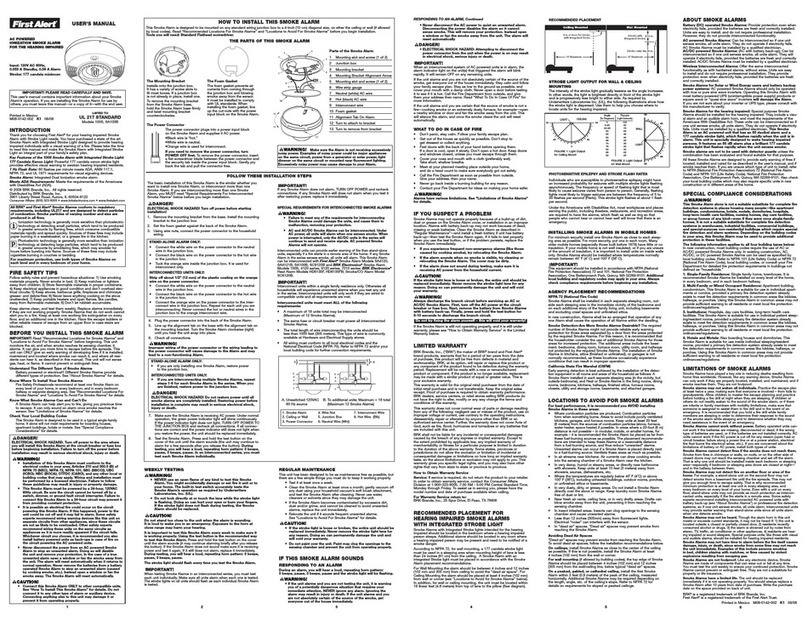
First Alert
First Alert SA4120 user manual

Kidde Technologies
Kidde Technologies SR2033 Operation & maintenance manual
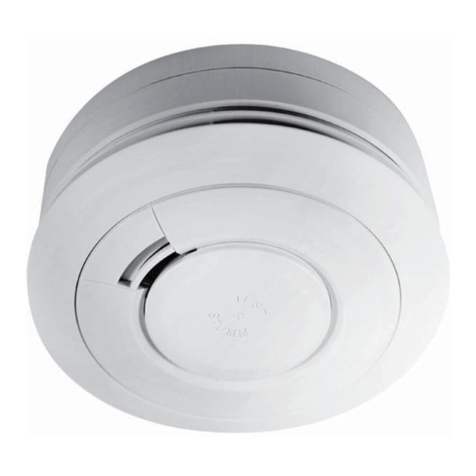
Ei Electronics
Ei Electronics Ei603 Series instructions
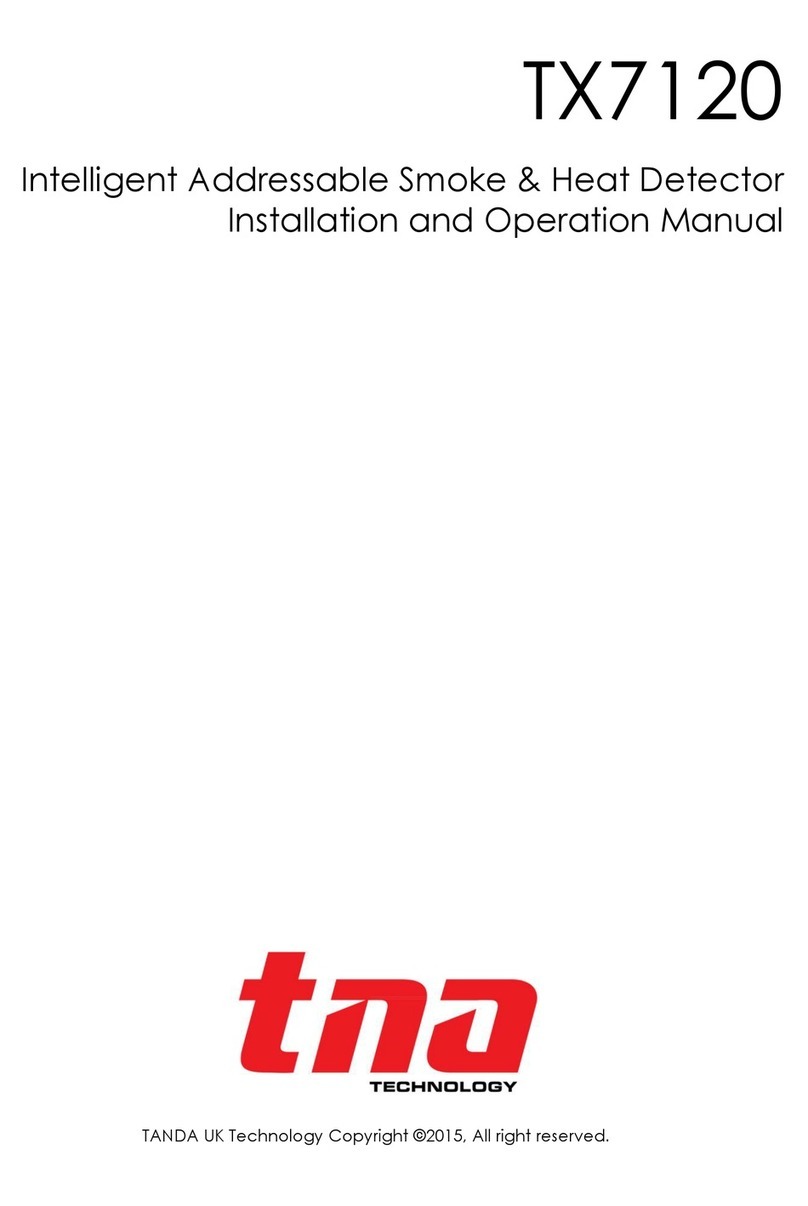
Tanda
Tanda TX7120 Installation and operation manual
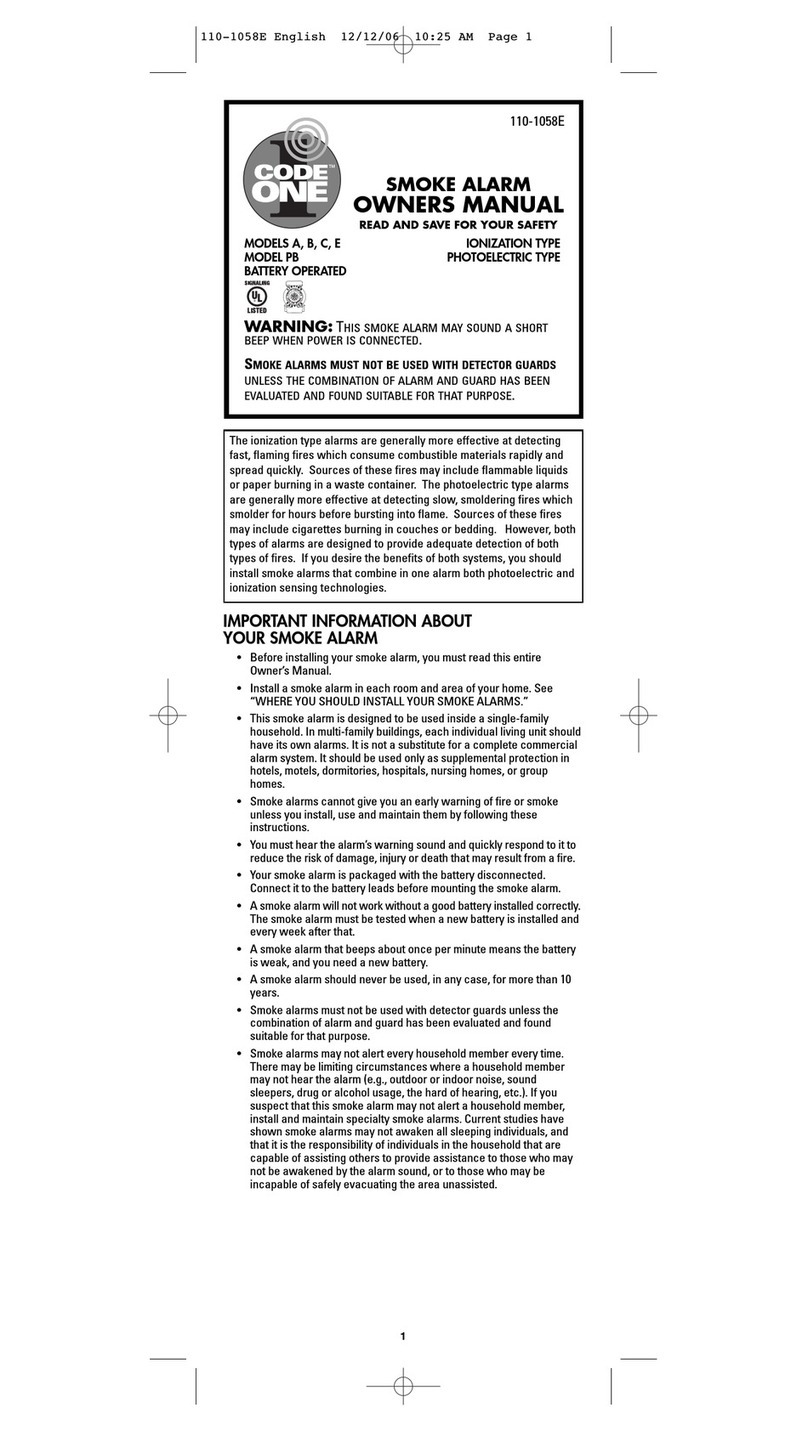
Code one
Code one A owner's manual

Teknim
Teknim TFD-1250 Installation & user manual


